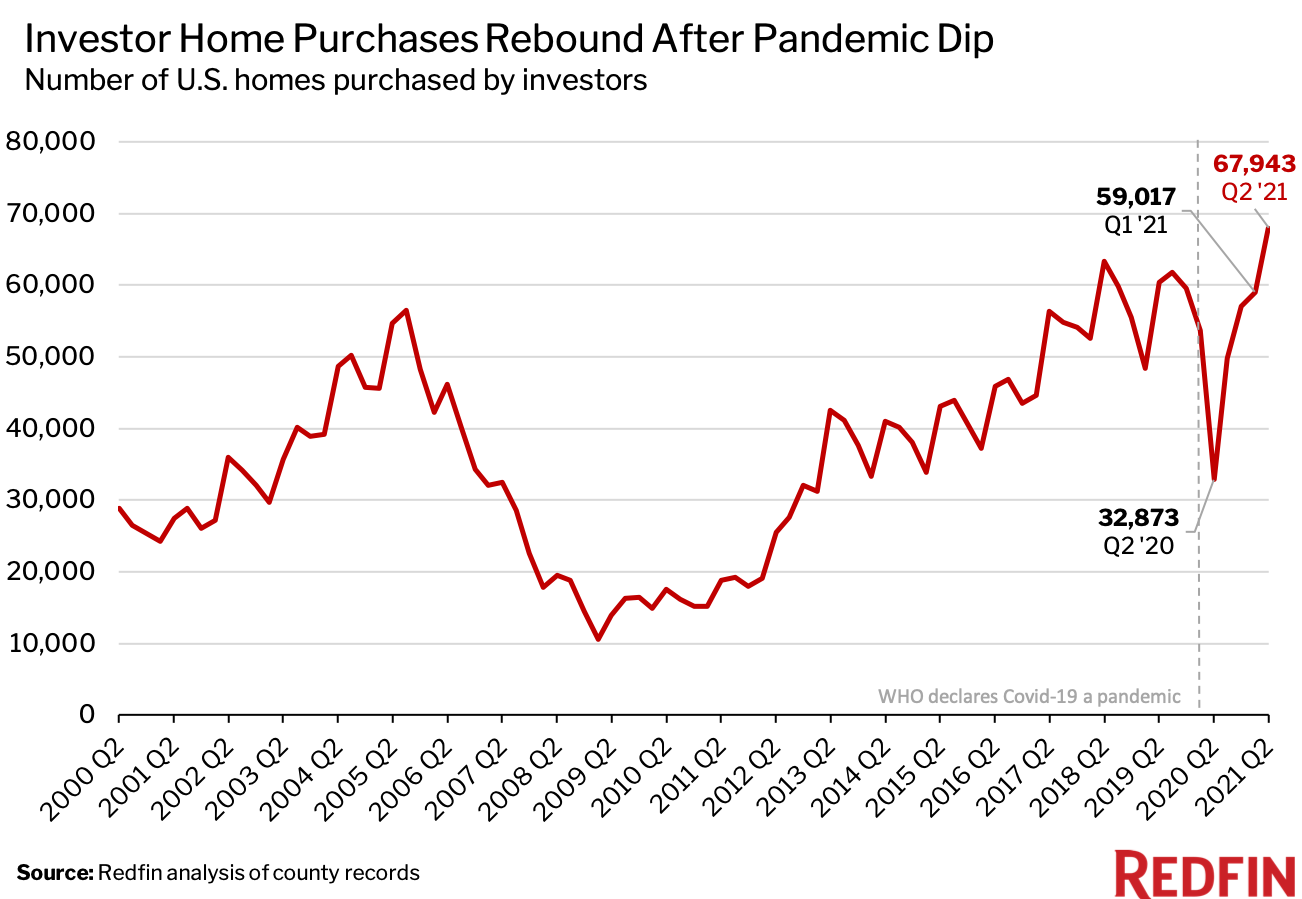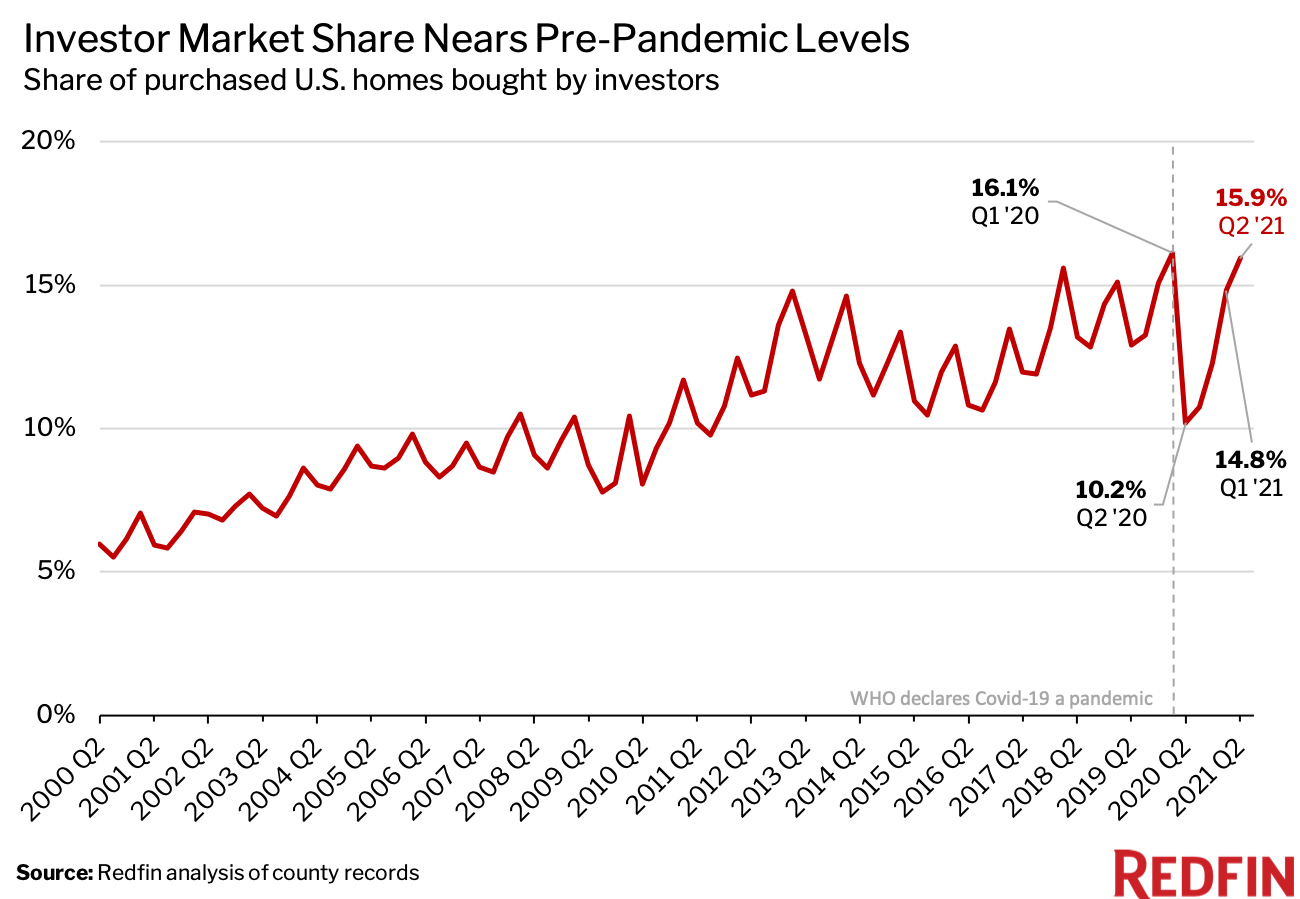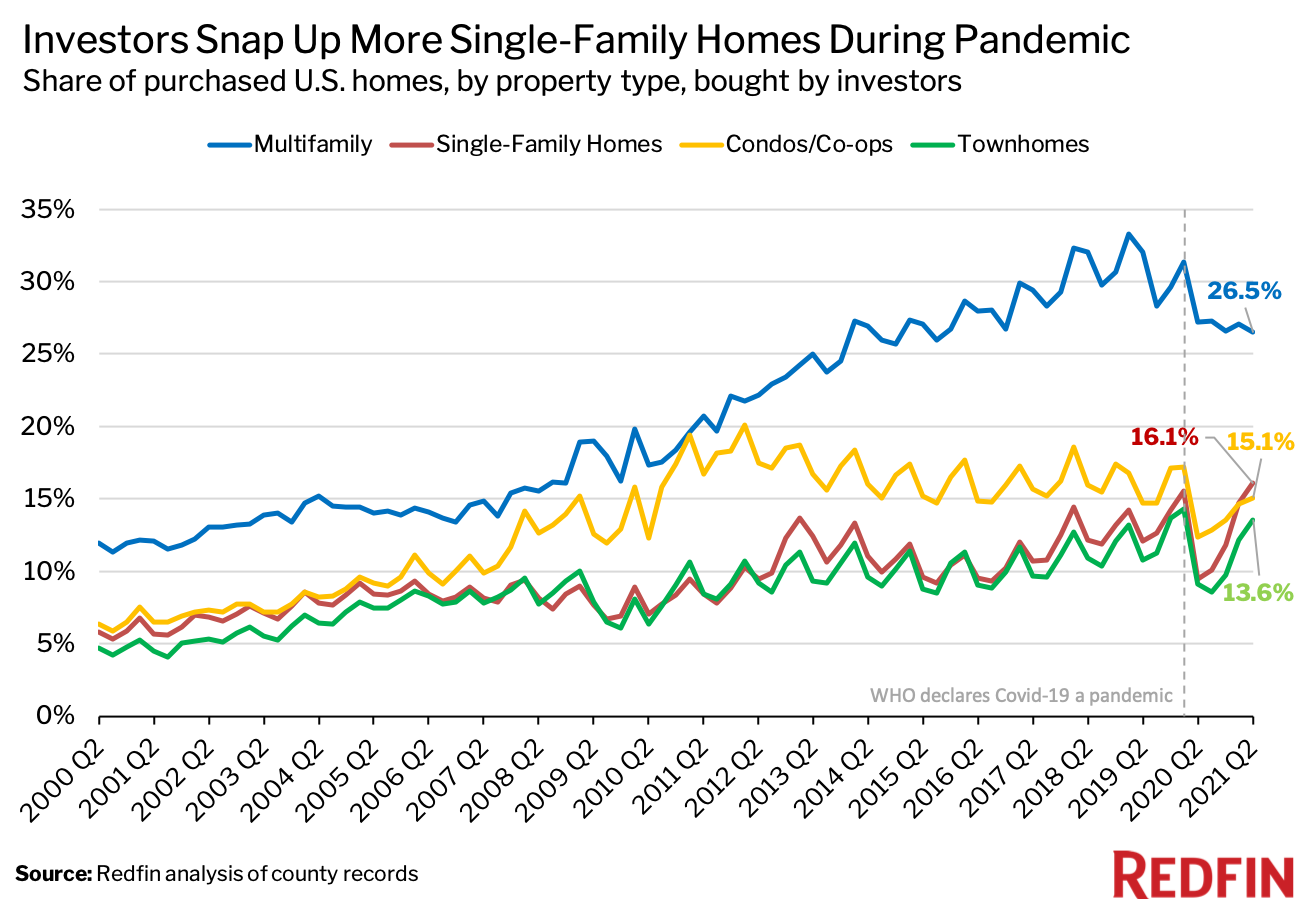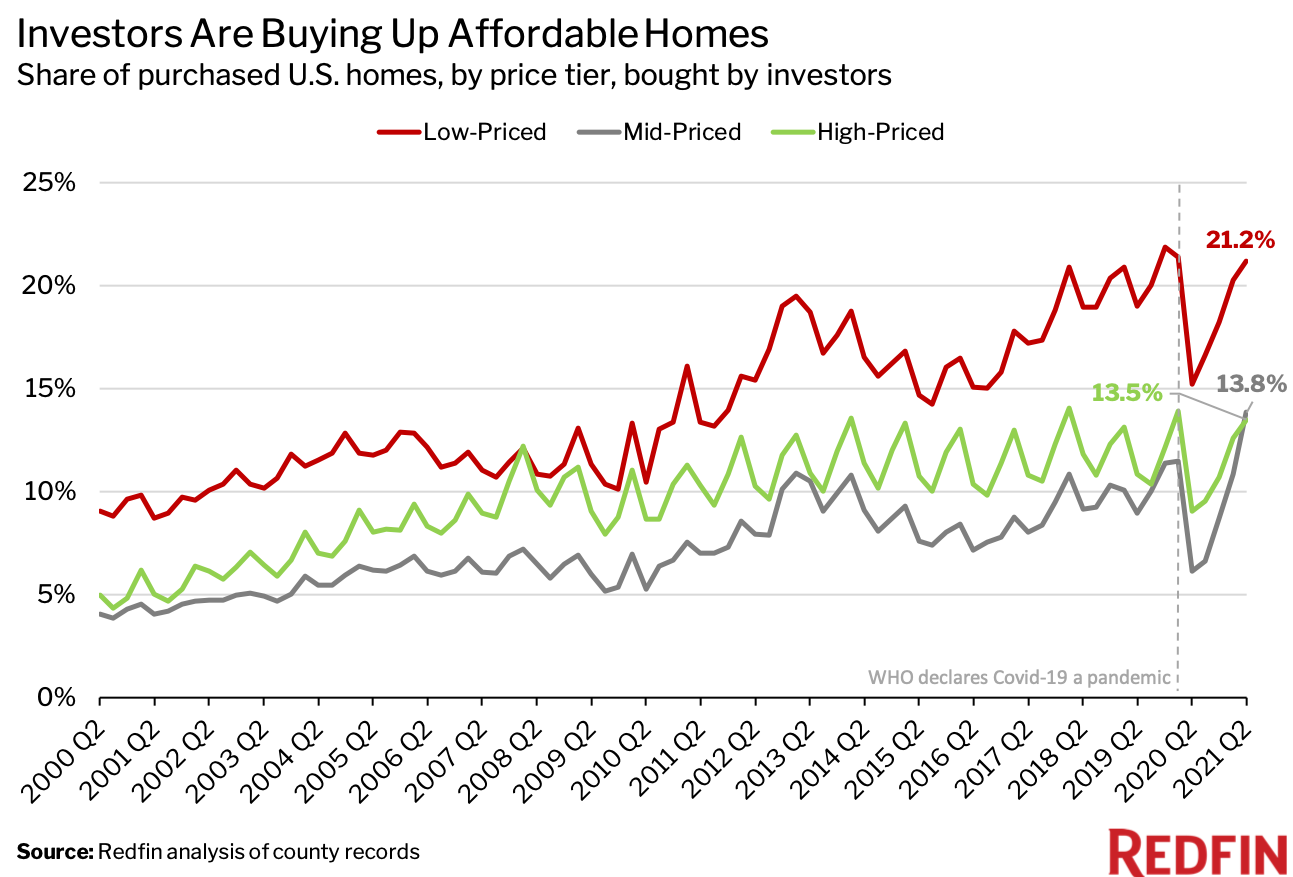Real estate investors purchased 67,943 U.S. homes in the second quarter of 2021—the highest quarterly figure on record. That’s up 15.1% from the prior quarter, and up 106.7% from the second quarter of 2020, when activity in the housing market was stalled due to pandemic restrictions.
In dollar terms, investors bought a record $48.5 billion worth of homes in the second quarter, up from $38.9 billion in the prior quarter and $20.9 billion a year earlier. The typical home they purchased cost $439,600—23.7% higher than a year earlier—amid surging housing prices.
We define an investor as any institution or business that purchases residential real estate. When we refer to a “record” in this report, the record dates back to the year 2000. Scroll to the bottom of this report to read the full methodology.

Investor market share has nearly returned to pre-pandemic levels. Investors bought about one of every six homes (15.9%) that were purchased in the second quarter of 2021—just shy of the 16.1% record market share they held in the first quarter of 2020, before the pandemic triggered an economic downturn.

“Investors see soaring home prices as an opportunity,” said Redfin Senior Economist Sheharyar Bokhari. “With housing values consistently on the rise, solid returns are pretty much guaranteed—especially when you’re an investor who has access to extremely cheap debt.”
Bokhari continued: “Investors are also taking advantage of surging demand in the rental market. With so many Americans priced out of homeownership, investors can turn an easy profit by buying up properties and renting them out.”
The jump in activity comes after investors pressed pause on home purchases last year amid economic uncertainty, pandemic shutdowns and a soft rental market.
“With investors throwing money at the housing market, some homebuyers are finding it tough to compete,” Bokhari said. “Investors frequently pay with all cash, which means they often have a much higher chance of winning bidding wars than buyers who take out mortgages.”
About three-quarters (74%) of investor home purchases in the second quarter were financed with all cash—the highest level since 2018.
So far this year, nearly one-third (30%) of overall U.S. home purchases have been paid for with all cash, according to a separate Redfin analysis. That’s up from 25.3% during all of 2020 and represents the largest share since 2014, with the rise in investor activity likely contributing to the increase.
While multifamily buildings are the most common property type purchased by investors, investor market share in this segment has declined during the pandemic. Investors bought about one-quarter (26.5%) of the multifamily properties that sold in the second quarter, down from a peak of one-third (33.3%) in 2019.
Meanwhile, investor market share of single-family homes and condos is on the rise after dropping during the pandemic. Investors purchased 16.1% of single-family homes and 15.1% of condos that sold in the second quarter, up from a pandemic low of 9.4% and 12.4%, respectively, a year earlier.

Single-family homes have been a hot commodity during the pandemic as house hunters have prioritized space and privacy over short commute times and proximity to cities. And now, with Americans returning to the office and single-family home prices through the roof, demand for condos is on the rise after dropping during the pandemic.
The low-priced segment of the market is the most popular with Investors—a trend that has held constant for decades. In the second quarter, one of every five low-priced homes that sold in the U.S. (21.2%) was purchased by an investor. That compares with 13.8% of mid-priced homes and 13.5% of high-priced homes. Price tiers are based on local sale prices.

In Phoenix, almost one-quarter (24.5%) of homes that sold in the second quarter were purchased by investors—the highest share of the 41 U.S. metropolitan areas Redfin analyzed. Next came Miami (24.2%), Atlanta (23.6%), Charlotte, NC (22.8%) and Las Vegas (22.8%).
In recent years, investors and individual homebuyers alike have crowded into mid-sized cities that are more affordable and offer more space than major hubs like San Francisco and New York. The pandemic accelerated this trend, with so many Americans suddenly able to work from anywhere. Phoenix was the most popular migration destination in the second quarter for Redfin.com users looking to move to a different metro. Miami and Las Vegas were also in the top five.
“Home prices in Phoenix have been surging, which means a lot of long-time residents have been priced out of the market and need to rent. Investors are moving in, buying up homes and turning them into rentals,” said Kristi Penrod, a designated broker with Redfin in Phoenix. “Phoenix still feels relatively inexpensive to a lot of investors—especially those who have been doing business in pricier cities like San Francisco or New York.”
Penrod continued: “Housing inventory is also improving, with more homeowners now putting their properties up for sale. Investors see this as a window of opportunity because it means they’ll deal with fewer bidding wars and are less likely to have to offer above the asking price.”
In Providence, RI, just 6.4% of homes that sold in the second quarter were bought by investors—a lower share than any other metro in this analysis. It was followed by Warren, MI (6.7%), Washington, D.C. (6.9%), Virginia Beach, VA (7.7%) and Montgomery County, PA (7.8%).
For this analysis, we looked at county sale records for homes purchased from January 2000 through June 2021. We define an investor as any buyer whose name includes at least one of the following keywords: LLC, Inc, Trust, Corp, Homes. We also define an investor as any buyer whose ownership code on a purchasing deed includes at least one of the following keywords: association, corporate trustee, company, joint venture, corporate trust. This data may include purchases made through family trusts for personal use.
We analyzed home sales in the 50 most populous metro areas, but only included 41 metros in this report due to non-disclosure of sale prices in several counties.
For the price-tier analysis, we looked at all home sales in a given year and sorted each sale into one of three buckets: low-priced, mid-priced or high-priced. Low-priced means a home’s sale price was in the bottom tercile of local sale prices, while mid-priced means it was in the middle tercile and high-priced means it was in the top tercile.
When we refer to a “record” in this report, the record dates back to the year 2000.


